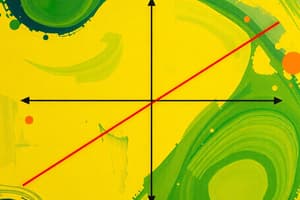Podcast
Questions and Answers
What does the production function Q = F(K, L) represent?
What does the production function Q = F(K, L) represent?
- The preferences of consumers for different goods.
- The relationship between output and inputs used in production. (correct)
- The total profit a firm earns from its operations.
- The amount of income generated by the firm.
What are increasing returns to scale?
What are increasing returns to scale?
- Output decreases when inputs are increased.
- Output increases less than proportionately when inputs are increased.
- Output increases more than proportionately when inputs are increased. (correct)
- Output exactly doubles when inputs are doubled.
Which of the following is NOT considered an input in the production function?
Which of the following is NOT considered an input in the production function?
- Capital
- Demand for goods (correct)
- Buildings and machines
- Labor
Why can we not freely transform the production function like a utility function?
Why can we not freely transform the production function like a utility function?
What generally holds true for production functions according to the assumed conditions?
What generally holds true for production functions according to the assumed conditions?
What characterizes a production function with increasing returns to scale?
What characterizes a production function with increasing returns to scale?
Which function represents constant returns to scale?
Which function represents constant returns to scale?
What is the definition of Marginal Product of Labor (MPL)?
What is the definition of Marginal Product of Labor (MPL)?
If a function F(K, L) yields F(2K, 2L) = 3Q, what type of returns to scale does it exhibit?
If a function F(K, L) yields F(2K, 2L) = 3Q, what type of returns to scale does it exhibit?
Which of the following production functions represents decreasing returns to scale?
Which of the following production functions represents decreasing returns to scale?
What happens to the marginal product of capital (MPK) as additional units of capital are added while keeping labor fixed?
What happens to the marginal product of capital (MPK) as additional units of capital are added while keeping labor fixed?
How does the marginal product of labor (MPL) change when the amount of capital is increased and labor is held constant?
How does the marginal product of labor (MPL) change when the amount of capital is increased and labor is held constant?
What does diminishing returns to capital imply when labor is held constant?
What does diminishing returns to capital imply when labor is held constant?
What is the effect on total production when both capital and labor are increased simultaneously?
What is the effect on total production when both capital and labor are increased simultaneously?
Which statement is true regarding the productivity of labor as more workers are added with fixed capital?
Which statement is true regarding the productivity of labor as more workers are added with fixed capital?
What is the relationship between fixed labor and the effect of adding capital to productivity?
What is the relationship between fixed labor and the effect of adding capital to productivity?
Which concept refers to the situation where output increases at a decreasing rate due to increases in one input with the other held constant?
Which concept refers to the situation where output increases at a decreasing rate due to increases in one input with the other held constant?
Why does the productivity of capital decrease as more units of capital are added with fixed labor?
Why does the productivity of capital decrease as more units of capital are added with fixed labor?
What is the significance of the Cobb-Douglas production function in economic modeling?
What is the significance of the Cobb-Douglas production function in economic modeling?
If both capital and labor are increased by the same percentage, what is expected in terms of overall production?
If both capital and labor are increased by the same percentage, what is expected in terms of overall production?
Flashcards
Returns to Scale
Returns to Scale
A concept describing how output changes when all inputs are increased proportionally. A function exhibits increasing, constant, or decreasing returns to scale depending on whether output increases more, equally, or less than the proportional increase in inputs.
Constant Returns to Scale
Constant Returns to Scale
A production function exhibits constant returns to scale if doubling all inputs results in exactly double the output. In general, if you multiply all inputs by a factor 'z', output also multiplies by 'z'.
Marginal Product of Labor (MPL)
Marginal Product of Labor (MPL)
The additional output produced when one additional unit of labor is employed while holding all other inputs constant. It's the partial derivative of the production function with respect to labor.
Marginal Product of Capital (MPK)
Marginal Product of Capital (MPK)
Signup and view all the flashcards
Cobb-Douglas Production Function
Cobb-Douglas Production Function
Signup and view all the flashcards
Production Function
Production Function
Signup and view all the flashcards
Inputs in Production
Inputs in Production
Signup and view all the flashcards
What are the two primary inputs in production?
What are the two primary inputs in production?
Signup and view all the flashcards
What is the difference between a production function and utility function?
What is the difference between a production function and utility function?
Signup and view all the flashcards
Diminishing Returns to Input
Diminishing Returns to Input
Signup and view all the flashcards
Why does MPK fall as capital increases (holding labor fixed)?
Why does MPK fall as capital increases (holding labor fixed)?
Signup and view all the flashcards
What is the effect of adding more workers to a fixed amount of capital?
What is the effect of adding more workers to a fixed amount of capital?
Signup and view all the flashcards
Why does MPK increase as labor increases (holding capital fixed)?
Why does MPK increase as labor increases (holding capital fixed)?
Signup and view all the flashcards
Cobb-Douglas Function: Returns to Scale
Cobb-Douglas Function: Returns to Scale
Signup and view all the flashcards
Cobb-Douglas Function: Diminishing Returns
Cobb-Douglas Function: Diminishing Returns
Signup and view all the flashcards
What is the meaning of MPK and MPL in production?
What is the meaning of MPK and MPL in production?
Signup and view all the flashcards
How are MPK and MPL related?
How are MPK and MPL related?
Signup and view all the flashcards
Study Notes
Introduction to Production
- Economics previously focused on consumer demand.
- This section introduces the supply side, focusing on production.
Production Functions
- Firms produce a single good.
- Two main inputs: labor (workers) and capital (buildings, machinery, tools).
- Production function describes how inputs combine to produce output (Q = F(K,L)).
- Unlike utility functions, production functions have physical meaning (e.g., producing 100 apples).
- Transformations of the function aren't permitted without impacting the meaning.
- Returns to Scale:
- Increasing: Output more than doubles when inputs double.
- Constant: Output doubles when inputs double.
- Decreasing: Output less than doubles when inputs double.
Marginal Product
- The marginal product of capital (MPK) measures additional output from one more unit of capital, holding labor constant.
- The marginal product of labor (MPL) measures additional output from one more worker, holding capital constant.
- As capital increases with labor held constant, MPK tends to fall (diminishing returns). The same logic applies to additional labor.
Marginal Rate of Technical Substitution (MRTS)
- The MRTS measures the rate at which one input can be substituted for another while maintaining a constant output level.
- MRTS = MPL/MPK. This ratio indicates the relative productivity of labor and capital.
- A constant MRTS suggests a constant rate of substitution between inputs.
Isoquants
- Isoquants are similar to indifference curves in consumer theory.
- Isoquants show all possible combinations of inputs (K and L) that produce a specific level of output (Q).
- The slope of an isoquant represents the MRTS (negative of MRTS).
Studying That Suits You
Use AI to generate personalized quizzes and flashcards to suit your learning preferences.




